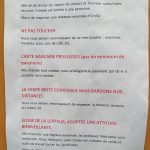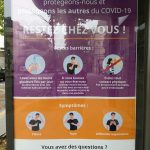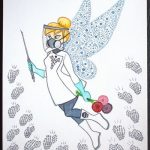International Coronavirus Labor Day Weekend
Friday marked La Fête du Muguet (Lily of the Valley Day) in France and it’s also widely known as International Labor Day (La Fête du Travail). Because it’s the year of coronavirus, most people already have the day off due to lockdowns and even some of the essential workers are taking advantage of resting today. My husband also had the day off. We went for our allowed one hour exercise walking around the neighborhood and noticed a note on a nearby tabac shop stating that it was closed for the day and would resume on May 2. Passed by again Saturday and sure enough, the tabac shop had a small, patient line of customers waiting in marked areas on the ground for their turn to enter. Normally you’d see bouquets or small pots of Lily of the Valley being sold on the streets by florists or individual sellers. Also, normally a permit is required to sell anything on the street, but it’s waived for this special occasion day. This is a public holiday so normally many stores, including many restaurants, would be closed to honor laborers and the rights that these workers have fought for. Normally, as part of celebrating Labor Day in France and other parts of the world, it would also be a day of demonstrations geared towards keeping and bettering worker’s rights. This has been, probably by far, the most significant and twisted year for International Labor Day because of COVID-19 and the rights and protections people have, believe they have, or should have. For many, it’s not even all about workers’ rights, but their own individual rights.
Protests this year for labor rights in some countries were either adapted by making a presence from one’s own balcony or simply ignoring the lockdown rules in order to make a statement. They weren’t just for worker’s rights and safety, but about how their governments have responded in the handling the pandemic. In the US, essential workers went on strike to demand more protective measures for their health and safety. OSHA does outline how working environments should operate as well as how employees should be protected, but it’s unclear whether or not these are being followed, if the safety measures were enough, or if they were put in place in time. I can’t help but think of meatpacking plants which have had to close because thousands of workers got sick followed by an executive order to keep them open and running. However, keeping them open won’t be easy if enough people have gotten sick. Workers at these plants don’t have much choice but to continue because they live paycheck to paycheck. Out of curiosity I decided to check out the Interim Guidance from CDC and the Occupational Safety and Health Administration (OSHA) for meat and poultry processing facilities during COVID-19 because according to a BBC article regarding the order to keep the plants open, the safety measures aren’t being deemed “mandatory.” I decided to just do a word count to get a sense of how serious and stringent these guidelines were. The word “required” appears 6 times, the word “must” appears 8 times, and the word “should” appears 56 times. The word “mandatory” doesn’t show up at all.
Besides protesting for health and safety, Friday was another day for US citizens to protest the lockdown measures and was named MAGA May Day which also gives these protests the look and feel of campaign rallies. Nurses came out to counterprotest the protesters to remind them that healthcare workers lives are being affected by their actions. Over 9,000 of the total coronavirus cases are healthcare professionals according to the CDC as of April 17. Also, over 90% of US nurses are women so it goes without saying that most of the nurses protesting were women. Meanwhile, some US states are already reopening malls, restaurants, and salons. Many fear it’s too soon and will bring new infection cases back up which might come in the next couple weeks after gathering in close proximity. Others see it as a right and freedom to take their own risk, live, and work so that they can pay their rent/mortgages… or get that long overdue haircut according to what I’ve been seeing online. One positive note is that COVID-19 seems to spread more easily indoors than outdoors so hopefully any rise in cases from the protests won’t be too significant and hospitals won’t be too burdened. Plus, businesses are saying they’re taking measures in order to protect their employees and the public. Again, we’ll see in a couple of weeks. Dr. Fauci, who’s served in the National Institute of Allergy and Infectious Diseases for the last 6 presidents, along with the rest of the medical community have been advocating for the country to stay at home.
So where is the US currently? So far, roughly 30 million Americans have filed for jobless claims. It was considered “Shattering Records” when only 3.3 million signed up on March 26 according to NPR. Congress has passed 4 relief bills which have included $1200 to every citizen and a Payment Protection Program for small businesses. However, there’s been criticism of how the relief money has already been spent. Some publicly traded companies have gotten money intended for small businesses. Some individuals may not be getting money because of one factor or another like being married to an immigrant. Some people lucky enough to keep their job still risk exposure because they work can’t be done by telecommuting. Medical bills for coronavirus treatment vary wildly with totals for the most severe cases at close to $75,000. Those in the most danger being healthcare professionals all over the world who have been lamenting the lack of PPE (Personal Protective Equipment).
France has been doing its best to keep people from becoming jobless. Steps have included reimbursing businesses for giving their employees partial payment while staying at home or full payment for those who make only minimum wage. Healthcare workers are expected to receive a bonus. Businesses are also being allowed to compel their employees to take mandatory holidays up to 6 days or even lengthen work hours for jobs requiring extra care such as energy, logistics, and telecom. Even the self-employed are getting some kind of financial package. So far there isn’t anything for suspending mortgage payments, but businesses and the self-employed will be able to temporarily suspend rent, gas, and electric. For essential workers who are currently operating in areas such as grocery stores, glass or plastic have been installed in stores to guard employees and customers and masks and/or face shields have been provided. Limits have been placed on in store capacity to help with social distancing. I’ve seen stores post rules on the storefront reminding people not to touch anything and to be mindful of their surroundings.
Some workers who haven’t felt they haven’t gotten the proper protections, such as bus drivers and school teachers, have walked off the job in order to voice their concerns. Walking off the job happens to be a worker’s right in France and cannot be fired if the employer is given notice and the reason is because of serious danger to their health. Doctors and nurses in France have called for more protective measures, PPE, in order to keep from contracting and spreading the disease.
Like the US, the people on the streets in France are mixed with some wearing masks, some not wearing them correctly, and some not wearing them at all. Most, however, do take the polite precaution of giving each other space when walking on the sidewalk. At least that’s been my limited outdoor experience. It’s hardest to avoid being near someone in the narrower streets. I remember in the very beginning when you’d see maybe a handful of masks in early March. Today was about 70%. I don’t think would get up to 100% mask coverage, but it will be mandatory in places like transport and schools.
A couple more thoughts on the US because I can’t help but think about US gig workers and the how they make up about 35% of the US workforce. Other names for gig workers are freelancers or independent contractors. For years, it’s become more and more common for people to work more a side job to supplement their traditional paycheck while others piece together multiple side gigs while some have just the one freelance career. People work these freelance jobs for many reasons from personal health situations, to flexibility, the love of being one’s own boss, or because their regular job doesn’t cover all the bills. With unemployment at such a mind-blowing scale, how much protection do they have in a time of crisis? But that’s just it isn’t it? It’s their freedom and choice to take such a risk. According to the National Employment Law Project, this pandemic is highlighting the problems that employees face from being misclassified as independent contractors and therefore are left out of possible unemployment benefits or paid sick leave. Some states have made strides in providing more protection, but that’s just some states. There are guidelines for what freelancers are eligible for as far as unemployment goes. If most of your income was from freelancing, how much would having a traditional job dictate what you would get in unemployment? If each state has different insurance programs regarding unemployment, which state will fair better and which state will suffer the most? What does this all mean in the future for the self-employed, for gig workers? It’s not just a question of what rights they have now, but what rights should they have in the future; because even though freelancing may mean more freedom, it can also mean landing in a bigger trap when conditions are just like how they are now. Relief money still has not come for independent stylists that I know who have families to provide for.
Lastly, safety measures were put in place in Stillwater, Oklahoma requiring masks for the public when entering businesses which would help protect themselves and the employees in the stores they walk into. It was then changed to now be only optional for customers. Employees were receiving verbal and physical threats because the requirement was considered unconstitutional and threatened their rights. Is it though? When a disease is more easily spread indoors and can linger on surfaces between a few hours to a few days, then isn’t it rational to want to protect employees in those establishments who have to work indoors for hours on end everyday? How do those workers feel about customers freely breathing, sneezing, coughing, and touching everything; who can then simply leave the establishment while employees are left exposed in that air for the rest of the day? What rights do they have? Isn’t it covered in OSHA that employers and employees have a right to control their environment to protect their health? Just asking for the citizens of Stillwater and everyone else concerned with getting sick at work. The rollback on this safety measure happened on Friday, International Labor Day.











